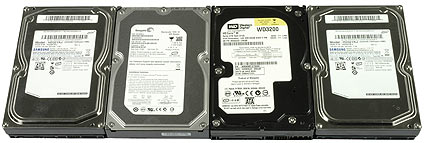Can Heterogeneous RAID Arrays Work?
Array Details
We decided to only use four hard drives, as this is probably the amount people widely use. Deploying more drives typically increases performance, but it also increases the theoretical chance of disk failure. If there are six or seven drives, the probability that one or more fails is higher. We also decided against using high capacities although up to 1 TB per hard drive is available today; most of our benchmarks require a rather significant amount of time if the partitions become too large.
We ran all tests in RAID 0 and in RAID 5, to offer a snapshot of the maximum performance as well as performance under redundant conditions.
Homogenous RAID
We used four Samsung HD321KJ hard drives for testing the homogenous RAID array. These drives come with a SATA/300 interface and 16- MB cache and they rotate at a 7,200 RPM spindle speed. The Spinpoint T166 is available at up to 500 GB per hard drive. We used the 320 GB version and we’d recommend going for the faster Spinpoint F1 if you choose to go with Samsung hard drives. However, we used these drives since their rather small capacity allows for our benchmarks to terminate quickly. If you intend to setup a server with SATA hard drives, then we recommend choosing a product that is validated for 24/7 operation. The Hitachi Ultrastar A7K1000, Seagate’s Barracuda ES or the Western Digital RAID Edition drives are possible choices. All of them are based on their desktop siblings, but are adjusted for enterprise applications.
Heterogeneous RAID
The heterogeneous RAID setup consists of two of the Samsung hard drives mentioned in the paragraph above. To really mix and mash the drives, we decided to get two other 320 GB hard drives from two different manufacturers with clearly different technical specs. The third drive is a Seagate Barracuda 7200.10 ST3320620AS and the fourth choice is Western Digital’s Caviar SE WD3200JD. Different from the Samsung and Seagate drives, the WD isn’t based on two platters, but runs a three-platter design. Seagate’s Spinpoint F1 stores 320 GB on a single platter; others still are limited to 250 GB per platter. The WD drive has even less per-platter capacity, with SATA/150 instead of SATA/300 and only 8 MB cache, but we thought the device was particularly appropriate for our purposes, which was to create a scenario with three entirely different drives.
Get Tom's Hardware's best news and in-depth reviews, straight to your inbox.

Patrick Schmid was the editor-in-chief for Tom's Hardware from 2005 to 2006. He wrote numerous articles on a wide range of hardware topics, including storage, CPUs, and system builds.
-
Typically, I'd say, run RAID-1. When it's time to upgrade, get two more identical drives, plug-em in and set up another mirror. Then, for Windows, delete your system hdd from the device manager and reboot to a Norton Ghost CD (assuming it supports your raid controller). Clone the partitions to new mirror. Power off, remove old mirror, boot to a new mirror. It will most likely re-detect the new mirror and request a re-boot, after that you're good to go on. Old drives can be wiped and sold on e-bay. Or turned into a backup volume.Reply

